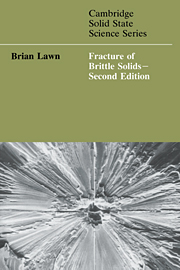Book contents
- Frontmatter
- Contents
- Preface
- Glossary of symbols and abbreviations
- 1 The Griffith concept
- 2 Continuum aspects of crack propagation I: linear elastic crack-tip field
- 3 Continuum aspects of crack propagation II: nonlinear crack-tip field
- 4 Unstable crack propagation: dynamic fracture
- 5 Chemical processes in crack propagation: kinetic fracture
- 6 Atomic aspects of fracture
- 7 Microstructure and toughness
- 8 Indentation fracture
- 9 Crack initiation: flaws
- 10 Strength and reliability
- References and reading list
- Index
8 - Indentation fracture
Published online by Cambridge University Press: 14 January 2010
- Frontmatter
- Contents
- Preface
- Glossary of symbols and abbreviations
- 1 The Griffith concept
- 2 Continuum aspects of crack propagation I: linear elastic crack-tip field
- 3 Continuum aspects of crack propagation II: nonlinear crack-tip field
- 4 Unstable crack propagation: dynamic fracture
- 5 Chemical processes in crack propagation: kinetic fracture
- 6 Atomic aspects of fracture
- 7 Microstructure and toughness
- 8 Indentation fracture
- 9 Crack initiation: flaws
- 10 Strength and reliability
- References and reading list
- Index
Summary
We turn now to a special kind of fracture, that produced by the contact of a hard indenter on a brittle surface. Indentation fracture, so-called, is of historical as well as practical interest. It dates back to 1880 with the celebrated studies of Hertz (see Hertz 1896) on conical fractures at elastic contacts between curved glass surfaces. The fully developed Hertzian cone crack is the prototypical stable fracture in brittle solids. Shortly after Hertz, Auerbach (1891) showed empirically that the critical load to initiate cone fractures in flat specimens is proportional to the radius of the indenting sphere, Pc ∝ r. For 75 years, ‘Auerbach's law’ remained one of the great paradoxes in fracture theory: the notion that fracture should initiate when the maximum tensile stress in the Hertzian field just equals the bulk strength of the material implies an alternative relation, Pc ∝ r2. Resolution of the paradox awaited the advent of modern-day fracture mechanics (Frank & Lawn 1967). More recently, radial–median cracks produced in elastic–plastic fields by diamond pyramid indenters have assumed centre stage. The radial crack system is now arguably the most widely used of all fracture testing methodologies in the mechanical evaluation of brittle materials.
- Type
- Chapter
- Information
- Fracture of Brittle Solids , pp. 249 - 306Publisher: Cambridge University PressPrint publication year: 1993
- 30
- Cited by



